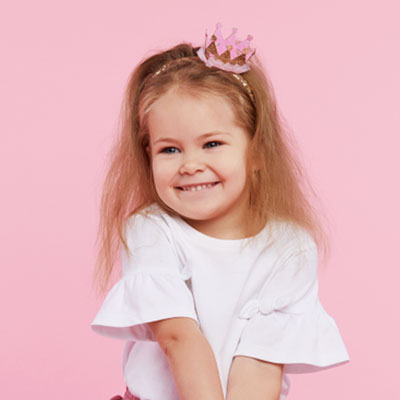Dental
A traumatic injury or a big cavity can leave a child’s tooth without enough structure to support a filling. When that’s the case, a dental crown might be the best option for protecting and restoring the tooth.



Dental Crowns to the Rescue!
When a filling won’t do the trick after an injury, pulpotomy (baby tooth root canal) or large cavity, a dental crown may be needed to save and protect what’s left of a tooth. The crown covers the entire tooth to the gum line, restoring its natural size and shape. We can use dental crowns for a lasting solution on permanent teeth or as a way to preserve baby teeth until it’s time for them to fall out.
benefits of
Dental Crowns

Restores strength and function
A dental crown makes a damaged tooth stronger and restores it to its original shape and size, so kids can chew and speak properly.
Protects the tooth
Because a crown covers the whole tooth above the gum line, it can prevent breakage and reduce the risk of future cavities.
Lasts for a really long time
Dr. Parker uses modern techniques and materials to create durable crowns that will last for years to come.

Is a crown really necessary for a baby tooth?
In some cases, yes! While, of course, the baby teeth will fall out eventually, while they’re in place, they play a number of important roles, including saving space for the permanent teeth to erupt, guiding facial development, and helping kids chew and speak properly.
When a baby tooth that’s years away from falling out naturally is severely damaged or decayed, Dr. Parker could recommend restoring it with a pediatric dental crown. This will let your child chew their food and help maintain ideal spacing in their mouth, so their smile can continue to develop as it should.
What to expect when your child gets a dental crown
We offer several different types of dental crowns for kids, including stainless steel crowns, tooth-colored zirconia crowns and all-resin crowns. The type we recommend will depend on a number of factors, such as the location of the tooth, your child’s age and your budget.
Before starting the procedure, Dr. Parker will use kid-friendly language and techniques to explain what will happen and put your child at ease. Once your child is relaxed, we’ll let them choose a show to watch on the ceiling-mounted TV. Dr. Parker will then carefully numb the area, remove any decay and shape the remaining tooth to fit under the crown.
Because pediatric dental crowns are often pre-fabricated, she may be able to place the permanent crown right after preparing the tooth. Otherwise, she’ll protect your child’s tooth with a temporary crown, while their permanent one is being made. In either case, the final crown will be cemented to your child’s tooth and adjusted for optimal function and fit.

6
We recommend that kids have a dental cleaning once every six months.
1940s
Stainless steel crowns were first used in pediatric dentistry in the late 1940s.
1-2
Getting a dental crown usually takes one to two office visits.



